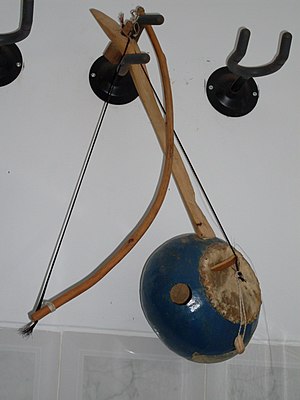Cimboa

A cimboa with its bow.
|
|
| String instrument | |
|---|---|
| Classification | String instrument |
| Developed | Cape Verde |
| Related instruments | |
| kiki, nini, fini (possible) | |
The cimboa (Portuguese pronunciation: [sĩˈboɐ], also in São Vicente Creole, Capeverdean Creole of ALUPEK: simboa or simbua), also known as the cimbó [sĩˈbɔ], is a musical instrument from Cape Verde. It is a bowed chordophone that was traditionally used to be played with the batuque dances.
The cimboa is composed of the instrument proper and its bow. The instrument belongs to the lute family, and so it possesses a neck attached to a sound box. The sound box is made of a calebash, or when it is hard to find, with a coconut shell, with a soundboard of stretched kid skin, fixed with reed pieces. Attached to the sound box there is a neck made of flexible wood (pine). At the end of the neck is a tuning peg of mahogany to tune the sole string of the instrument which is stretched between the nut set in the neck, and the bridge placed on the soundboard. The bow is made of a curved wood (called barnelo in Cape Verde) piece and strung with horse mane. Sound is produced by rubbing the bow on the instrument's string, which is also made of horse mane. The pitch of the notes is changed by pressing the string against several points on the neck. The neck's flexibility allows bending effects of the notes by bending the neck.
...
Wikipedia
